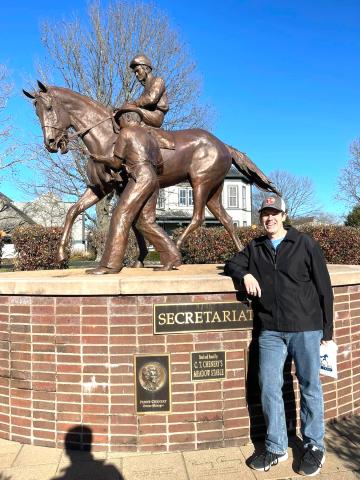The first female equine veterinarian in the United Sates
Have you ever had to take an animal to the veterinarian’s office?
I have, and I have also had to call them out to my house. Veterinarians are a very viable resource when it comes to keeping your animals healthy. I should know, because I worked at the University of Tennessee Veterinary Hospital in the Equine Rehabilitation Center for almost seven years before leaving in 2022.
Working there, I saw first-hand what equine vets, as well as technicians and other veterinarian assistants like myself, do on a daily basis. Today we are going to talk about the first female equine veterinarian in the United States, Dr. Margret Phyllis Lose. Sit back and enjoy the ride—yes, pun intended.
Phyllis was born November 15, 1925. Like myself, she started admiring horses at a young age. At the age of nine, she convinced her parents to help her buy a horse and keep it in their garage.
How many of us can say that their first horse lived in the family garage? She first had to have it approved by the local police station.
A few years later Phyllis’s pony had outgrown its garage stall and she had to convince her parents to let her rent a neighbor’s barn to board her pony. She used this as an opportunity to begin boarding horses for other people to make some money.
She did all of this by the age of 13. Tell me that is not savvy. With four years of horse experience under her belt, she began exercising racehorses at a racetrack by age 15.
Apparently, she had some near-death experiences due to the fact that, as most people know, racehorses are high-strung anyway. At 19, she convinced the track stewards to let her test and certify to become the youngest racehorse trainer in the country, becoming one of only three women trainers in the U.S. at the time.
At an early age, her dream was to become a veterinarian. The practice was mainly filled with men, but there were a few women vets. In 1957, her dream became reality when she graduated from the University of Pennsylvania Veterinary School. She was one of three women in her graduating class and the only woman who studied large animals.
From 1957 to 2022, this field has had a diverse change. According to the American Veterinary Medical Association in 2022, the veterinarian statistics in the United States shows there were 82,036 female and 41,658 male veterinarians.
Can you imagine what the people would think about this statistic 66 years ago? I would imagine they would have thought this would not have been possible.
After graduation, Dr. Lose had to prove herself to be just as good as a male veterinarian.
She took on bizarre cases such as deodorizing a pet skunk, working as the on-call veterinarian for the circus, and even tackling dangerous equine cases that other vets would not touch.
Hard work and determination allowed Dr. Lose to build her clientele base. With the help of movie star Grace Kelly, she was able to open her own private practice, Circle E Equine Hospital in Pennsylvania.
She opened two equine hospitals in Pennsylvania during her lifetime.
I mentioned earlier that I worked in the equine hospital at the University of Tennessee as veterinarian assistant. An environment such as this must be kept as clean as possible. Cleaning the facility and the stalls, feeding and watering the animals, and the other duties such as exercising the horses, helping with appointments, etc., keeps everyone on their toes.
Dr. Lose ran an extremely tight ship in the areas of cleanliness and sterilization, leading to her record of zero post-surgical infections. After reading this, in my opinion, any human or animal clinic/hospital should research what her protocols were and follow them to a “T.”
I guess I should go a step further and say why not use her protocol in our homes. I must brag on the rehabilitation crew at the vet school, the technicians, as well as the doctors, who made sure that if they gave injections, the horse was properly cleaned/sterile before sticking them with a needle.
After researching Dr. Lose, I must say she has had some incredible accomplishments throughout her lifetime such as being the first woman equine vet in the United States, and opening and running her own equine clinic and hospitals.
Her clinic was the first woman-owned and woman-run horse veterinarian clinic and the first woman to build an equine surgical hospital.
I feel her persistence and dedication paved the way for many others that followed in her footsteps.
Speaking of dedication, she stayed very busy at times and treated up to 1,000 horses a week with only about three or four hours a night of sleep. Talk about dedication and loving your job!
Dr. Lose never married, largely thought to be because she stayed so busy with her career.
Also, you cannot be a world-renowned vet if you have not written books and journals. A couple of her books include “Blessed are the Broodmares” and “Blessed are the Foals.”
If you would like to learn more about Dr. Lose, check out her autobiography, “No Job for a Lady.”
In 1999, at the age of 73, when most people are ready to retire, she moved to Florida and got a job working as a racetrack vet. Florida required her to re-take her veterinary board exams.
She told Veterinary Practice News, “I was the oldest person there. I had to take them on the computer, and I was still the first to finish.”
Sadly, in 2019 we lost this legendary icon. Dr. Lose was a true female leader. We can all learn something from her by following our dreams and not giving up.
If she had given up, would there be as many women entering the veterinarian workforce? Maybe not.
- Log in to post comments
